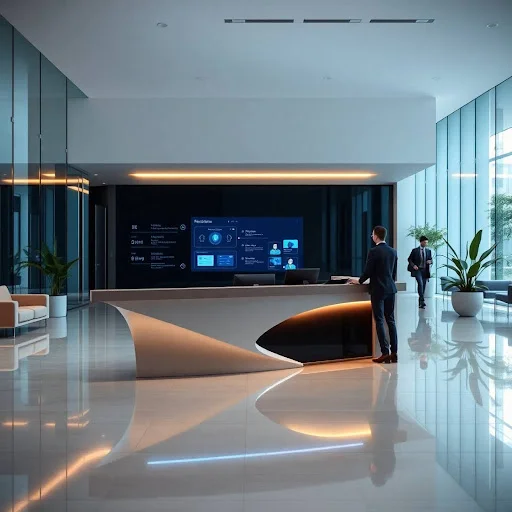In today’s business world, first impressions matter. Receptionists play a key role in shaping customer experiences. Now, businesses can choose between AI receptionists and traditional human receptionists. This article compares the two options to help businesses decide what’s best for them. We’ll look at how efficient, cost-effective, and personal each option is when dealing with customers.
| Key Takeaways | AI Receptionist | Traditional Receptionist |
| Availability | 24/7 Positive | Limited to office hours Negative |
| Cost | Lower long-term costs Positive | Higher ongoing salary and benefits costs Negative |
| Consistency | Consistent responses Positive | Variability depending on staff member Neutral |
| Complexity Handling | Limited for nuanced interactions Negative | Excellent for complex or emotional issues Positive |
| Scalability | Easily handles high call volumes Positive | Limited by individual workload Negative |
What Is an AI Receptionist?
Definition and Key Features
An AI receptionist is a computer system that handles customer interactions automatically. It can talk to customers on the phone, by email, or through chat. AI receptionists are a big step forward in customer service technology. They help businesses handle customer interactions more efficiently and can grow with the business.
How AI Receptionists Operate
AI receptionists use advanced technologies to understand and respond to customer questions. They can do tasks like:
- Greeting callers with a personalized welcome message
- Routing calls and inquiries to the right department or person
- Scheduling appointments and managing calendars
- Providing basic information about products, services, or company policies
- Capturing customer details for follow-up or database management
- Answering frequently asked questions with pre-programmed responses
- Handling multiple interactions at once, so no call goes unanswered
These AI systems learn and get better over time based on their interactions. They can also work with other business systems to provide a smooth customer experience.
Traditional Receptionist Setups
Role and Responsibilities
Human receptionists have many jobs in a business. They’re often the first person customers meet or talk to. Their responsibilities usually include:
- Greeting visitors in person and making them feel welcome
- Managing incoming calls and directing them to the right staff members
- Handling administrative tasks like sorting and distributing mail
- Managing sensitive communications and keeping things confidential
- Providing a personal touch to customer interactions
- Helping with basic office management tasks
- Coordinating meetings and managing conference room bookings
- Keeping visitor logs and making sure security rules are followed
Human Touch and Adaptability
One of the best things about human receptionists is how they handle complex or emotional conversations. They can change how they talk based on the situation and the person they’re talking to. Human receptionists can understand body language, get the context of a situation, and make decisions when things aren’t clear. This personal touch is something many customers still value a lot.
Also, human receptionists often get to know regular clients or visitors. This helps build relationships that can make customers happier and more loyal. They can also represent the company’s culture and values in a way that an AI system can’t.
Key Differences Between AI and Traditional Receptionists
| Aspect | AI Receptionist | Traditional Receptionist |
| Availability | 24/7 Positive | Limited to office hours Negative |
| Cost | Lower long-term costs Positive | Higher ongoing salary and benefits costs Negative |
| Consistency | Consistent responses Positive | Variability depending on staff member Neutral |
| Complexity Handling | Limited for nuanced interactions Negative | Excellent for complex or emotional issues Positive |
| Scalability | Easily handles high call volumes Positive | Limited by individual workload Negative |
| Empathy and Adaptability | Limited Negative | High Positive |
| Immediate Response | Instant Positive | May involve wait times Neutral |
Benefits of Using an AI Receptionist
Immediate Response and Efficiency
An AI receptionist answers calls right away, gets rid of wait times, and quickly routes calls. This can make customers happier and help businesses run smoother. AI systems can handle many questions at once, so no call goes unanswered, even during busy times. This quick response can be really helpful for businesses that get a lot of calls or work in time-sensitive industries.
Cost-Effectiveness
Using an AI receptionist system often costs less than hiring full-time or part-time reception staff. This can be especially good for small to medium-sized businesses trying to save money. There might be costs to set it up at first, but over time, businesses can save a lot on salaries, benefits, and training. Plus, AI receptionists don’t need breaks, sick leave, or holidays, so they can work all the time without extra costs.
Scalability for Growing Businesses
AI receptionists can easily handle more calls and questions as a business grows, without needing to hire more people. This makes them great for businesses that are growing or have busy seasons. As a business gets bigger, the AI system can be quickly updated to handle new products, services, or departments without needing a lot of retraining. This flexibility helps businesses keep their customer service quality good even when they’re growing or changing fast.
Advantages of Traditional Receptionists
Personalised Service and Human Empathy
Human receptionists are great at giving personal service and showing empathy. They can change how they talk based on how the caller feels, which is really important in industries where sensitive conversations happen a lot. Human receptionists can pick up on small clues in a caller’s voice or body language, helping them respond the right way to complex emotional situations. This ability to comfort, reassure, or listen sympathetically can be crucial in keeping good relationships with customers, especially in fields like healthcare, legal services, or counseling.
Flexibility in Complex Situations
Human receptionists are good at handling unexpected issues, urgent matters, or tricky requests that an AI system might not be able to deal with. This flexibility can be really important for keeping customer service quality high in different situations. Traditional receptionists can think quickly, make judgment calls, and find creative solutions to unique problems. They also know when to pass an issue to a manager or specialist. This human touch can be really valuable when dealing with sensitive situations or important clients who expect more personal service.
Additional Administrative Support
Besides handling calls and questions, human receptionists often help with other office tasks. This might include filing, preparing documents, and managing in-person client interactions, which can be especially helpful for smaller businesses with fewer staff. Human receptionists can also help with more complex tasks like basic bookkeeping, planning events, or arranging travel. Their ability to do many different tasks and adapt to the changing needs of the business throughout the day adds a lot of value beyond just answering phones.
Considerations When Choosing Between AI and Traditional Reception
Business Size and Call Volume
Choosing between an AI receptionist and a human one often depends on how big the business is and how many calls it gets. Smaller companies might prefer the personal touch of a human, while bigger companies with lots of calls might benefit more from an AI system that can handle more calls. For example, a small law firm might want a human receptionist who can build personal relationships with clients, while a large online store might choose an AI system to handle thousands of customer questions efficiently. Businesses should look at their call patterns, busy times, and how complex their typical questions are to decide which option is best for them.
Nature of Client Interactions
Businesses in areas like legal services, healthcare, or high-end consulting might need more sensitive communication. In these cases, the empathy and discretion of a human receptionist might be better. Industries dealing with private information or emotional situations might find that clients prefer talking to a human. On the other hand, businesses with simple, repetitive questions might find an AI system more efficient. It’s important to think about what your clients expect and how much personal attention they need in your interactions.
Budget and Resources
When deciding between AI and human receptionists, businesses need to think about both the initial costs and long-term savings. While AI systems might cost more to set up at first, they often save money over time, especially for businesses that get a lot of calls. Human receptionists have ongoing costs like salaries, benefits, and training, but they can do a variety of tasks and take on extra office work. Companies should look at their financial plans, growth goals, and how much return they might get on their investment for each option. It’s also worth looking into mixed approaches that use AI for efficiency but keep humans for handling complex issues.
Business Size and Call Volume
Smaller firms may prefer human touch, while larger companies with high call volumes benefit from AI scalability.
Nature of Client Interactions
Sectors like legal, healthcare, or high-end consultancy may require empathy and discretion of human receptionists.
Budget and Resources
AI may have higher initial setup costs but often proves more cost-effective over time, especially for high call volumes.
Conclusion
Choosing between an AI receptionist and a human one isn’t a one-size-fits-all decision. It depends on things like how big the business is, what customers need, how complex the calls are, and the budget. AI receptionists are great for efficiency, cost-saving, and handling lots of calls. Human receptionists are better at dealing with complex, emotional conversations and giving a personal touch.
Businesses should think carefully about what they need and consider using both AI and human receptionists together. As technology keeps improving, it’s important to be flexible and ready to change how you handle reception to best serve customers and help the business grow. Some companies might do well using AI for simple questions and call routing, while keeping human receptionists for more complex or sensitive situations.
In the end, whether you choose an AI receptionist or a human one, the goal should be to make customers happy, make the business run better, and support the company’s overall goals. It’s important to regularly check how well the chosen system is working and be willing to change as the business grows and changes. This will make sure that the reception solution keeps meeting the company’s needs and what customers expect.
“The future of reception lies not in choosing between AI and human, but in finding the right balance that best serves your business and your customers.”
— AI vs Traditional Receptionists Study





